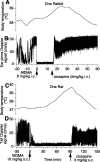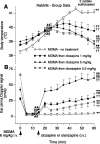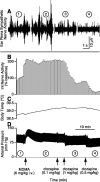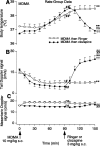Clozapine reverses hyperthermia and sympathetically mediated cutaneous vasoconstriction induced by 3,4-methylenedioxymethamphetamine (ecstasy) in rabbits and rats
- PMID: 12867524
- PMCID: PMC6740548
- DOI: 10.1523/JNEUROSCI.23-15-06385.2003
Clozapine reverses hyperthermia and sympathetically mediated cutaneous vasoconstriction induced by 3,4-methylenedioxymethamphetamine (ecstasy) in rabbits and rats
Abstract
Life-threatening hyperthermia occurs in some individuals taking 3,4-methylenedioxymethamphetamine (MDMA, ecstasy). In rabbits, sympathetically mediated vasoconstriction in heat-exchanging cutaneous beds (ear pinnae) contributes to MDMA-elicited hyperthermia. We investigated whether MDMA-elicited cutaneous vasoconstriction and hyperthermia are reversed by clozapine and olanzapine, atypical antipsychotic agents. Ear pinna blood flow and body temperature were measured in conscious rabbits; MDMA (6 mg/kg, i.v.) was administered; and clozapine (0.1-5 mg/kg, i.v.) or olanzapine (0.5 mg/kg, i.v.) was administered 15 min later. One hour after MDMA, temperature was 38.7 +/- 0.5 degrees C in 5 mg/kg clozapine-treated rabbits and 39.0 +/- 0.2 degrees C in olanzapine-treated rabbits, less than untreated animals (41.5 +/- 0.3 degrees C) and unchanged from pre-MDMA values. Ear pinna blood flow increased from the MDMA-induced near zero level within 5 min of clozapine or olanzapine administration. Clozapine-induced temperature and flow responses were dose-dependent. In urethane-anesthetized rabbits, MDMA (6 mg/kg, i.v.) increased ear pinna postganglionic sympathetic nerve discharge to 217 +/- 33% of the pre-MDMA baseline. Five minutes after clozapine (1 mg/kg, i.v.) discharge was reduced to 10 +/- 4% of the MDMA-elicited level. In conscious rats made hyperthermic by MDMA (10 mg/kg, s.c.), body temperature 1 hr after clozapine (3 mg/kg, s.c.) was 36.9 +/- 0.5 degrees C, <38.6 +/- 0.3 degrees C (Ringer's solution-treated) and not different from the pre-MDMA level. One hour after clozapine, rat tail blood flow was 24 +/- 3 cm/sec, greater than both flow in Ringer's solution-treated rats (8 +/- 1 cm/sec) and the pre-MDMA level (17 +/- 1 cm/sec). Clozapine and olanzapine, by interactions with 5-HT receptors or by other mechanisms, could reverse potentially fatal hyperthermia and cutaneous vasoconstriction occurring in some humans after ingestion of MDMA.
Figures




References
-
- Aghajanian GK, Marek GJ ( 1999) Serotonin and hallucinogens. Neuropsychopharmacology 21: 16S–23S. - PubMed
-
- Arnt J, Skarsfeldt T ( 1998) Do novel antipsychotics have similar pharmacological characteristics? A review of the evidence. Neuropsychopharmacology 18: 63–101. - PubMed
-
- Baldessarini RJ, Frankenburg FR ( 1991) Clozapine. A novel antipsychotic agent. N Engl J Med 324: 746–754. - PubMed
-
- Barnes NM, Sharp T ( 1999) A review of central 5-HT receptors and their function. Neuropharmacology 38: 1083–1152. - PubMed
Publication types
MeSH terms
Substances
LinkOut - more resources
Full Text Sources
Medical
